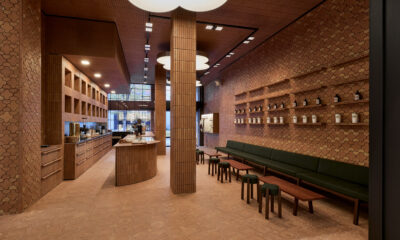Last year was a rough one for retailers and the store fixture manufacturers who depend on them. But there seems to be the glimmer of a recovery going on in 2010.
“We’re in the midst of the most activity we’ve had in five years,” says Mitch Abbott, global retail development manager for The Rockport Co. (Canton, Mass.). “We’ll be opening between 15 and 20 doors in the U.S. by the end of the year.”
Nordstrom Inc. (Seattle) is recovering from a drop in 2009 projects after a record year in 2008. “We have four more new stores on the books for 2010, plus five remodels,” says Susan Morton, director of interior design and concepts. “And in 2011, we will have three new stores and six remodels for a total of nine projects.”
Similarly, Gamestop Inc. (Grapevine, Texas), the world’s largest video game retailer, is seeing a rebound after things went a little soft in 2009. “This year, we’ll open about 250 new stores in the U.S., plus another 150 worldwide and up to 300 remodels,” says Jason Floyd, director of store development.
Sharon Lessard, vp of store design services at SuperValu Inc. (Eden Prairie, Minn.), says the nation’s second-largest supermarket operator will continue to remodel its store fleet. “Some locations hadn’t been touched in years,” she says, “and we need to bring them up to current design and merchandising programs.”
All that can only have a positive impact on store fixture manufacturers. The industry that has been reeling from the slumping economy is being awakened. But it’s also being asked to step up its game for what everyone hopes will be a new era of activity.
Together We Stand
Retailers say their fixture manufacturers will be called on to do more than just manufacture. They’re increasingly looking for fixture companies with problem-solving and design skills, too.
“Once we’ve explained our strategic intent, we expect a certain level of creative collaboration on what we’re trying to achieve,” says SuperValu’s Lessard. “We’re encouraging our fixture suppliers to bring ideas to the table.”
Jay Kratz, senior design manager for Luxottica Retail (Cincinnati), says his department will be doing a lot more of its own design work in-house. “So we’re relying more heavily on our fixture manufacturers to be an extra design resource,” he says. “Our concepts often begin with sketches on napkins. We want them to help turn the vague and general into the specific.”
He’s also suggesting his suppliers be more proactive. “Shoot me some ideas,” Kratz tells his Luxottica vendors. “Don’t wait for my specs. You know our finishes and hardware systems; give us some solutions.”
At Gamestop, “my department here is very small,” says Floyd. “and I’m not a designer. So I rely on suppliers with full design resources. They have to do their homework, get to know our stores and our customer demographics. Some customers are hard-core gamers, others are casual gamers looking for a family activity. Our suppliers have to understand that.”
Continuity and Experience
This increased emphasis on collaboration seems to tilt the board in favor of existing relationships, manufacturers who’ve been through the wars with their retail customers and proven themselves. And many retailers do seem to prefer those vendors with whom they’re already familiar.
“In 2010, we’re sticking with the same group of fixture manufacturers we used in 2008 and ’09,” says Nordstrom’s Morton. “They already understand our ways of doing things.”
“We put our fixture suppliers through a diligent round of prototyping,” says Rockport’s Abbott, “and the manufacturers who survive that are generally the ones who’ve worked with us before. It’s tough to get someone new into the fold.”
But even fixture manufacturers with ongoing client relationships might have to face a new economy. “At the end of 2008, we went to our current supply base and asked, ‘How can you help us find an additional 20 percent savings?’ ” says Bob Waddell, vp, construction/purchasing operations, at Limited Brands (Columbus, Ohio).
His suppliers responded by renegotiating some of their leases with landlords, reducing some of their fixed costs, going to their suppliers to get volume savings on materials and even, in one case, getting voluntary concessions from their employees on 10 to 15 percent salary cuts, just to keep the business in the house.
“As a result,” says Waddell, “We didn’t lose a single existing vendor for 2010. We didn’t have to put a single existing project out to re-bid.”
Besides, many retailers say squeezing their fixture manufacturers on price – especially during the reverse auctions and online bidding wars of earlier this decade – often proved counterproductive. Some manufacturers produced shoddy work, missed their deadlines and even dropped the ball completely trying to fulfill projects with razor-thin margins.
“We bid out every job to at least three suppliers,” says Gamestop’s Floyd, “but my best vendors are rarely the lowest cost. They have the best design, strong capabilities and they understand my business. They also offer turnkey service.”
Size and Service
Does that mean size matters? Sometimes. “If I’m looking for suppliers with design and engineering strength, that often means the larger companies,” says Rockport’s Abbott. “But with the bigger companies comes more overhead and higher prices. So I also have to find the direct fabrication houses that can provide the production quality and service I need.”
And retailers need the assurance that the manufacturer, large or small, is going to be there when it’s needed. “I visit their plant, ask for references and financials,” says Luxottica’s Kratz. “I need to be confident that they’ll be in business.”
But always up there on the short list of retailers’ priorities – along with quality, dependability and resourcefulness – is service. To Rockport’s Abbott, as to others, that means inventory management, quick turnaround, flexibility and, in his case, international resources. “We’re launching a global program,” he says, “so I need companies with international logistics networks and understanding of duties, imports, free-trade zones.”
“I need to have the full attention of the manufacturing company’s president,” says Nordstrom’s Morton. “If I’m opening a store and suddenly realize I need another wardrobe or tower, I have to know I can get that in a week.”
The recovery may be happening gradually, and the fixture manufacturing community may still be in worry mode, but it looks like there’s going to be a flurry of activity out there in 2010 and beyond. And for that business, the rules have never changed. The work will go to the fixture company that does the best job of reassuring its current and prospective clients it can bring everything necessary to the table.

 Headlines1 week ago
Headlines1 week ago
 John Ryan2 weeks ago
John Ryan2 weeks ago
 Headlines7 days ago
Headlines7 days ago
 Headlines2 weeks ago
Headlines2 weeks ago
 Headlines1 week ago
Headlines1 week ago
 Retail Buzz3 days ago
Retail Buzz3 days ago
 Headlines1 week ago
Headlines1 week ago
 Headlines1 week ago
Headlines1 week ago












